|
|
|
Nepal is not only the land of mountains, but, also the land of festivals. About more than 50 festivals are celebrated in Nepal every year. While the national festivals have fixed dates, religious festivals follow the lunar calendar, which does not coincide with the solar calendar. All these festivals are celebrated with enthusiasm and galore and all the people take part in these festivals. Some of the festivals which are celebrated in Nepal are Sweta Machhendranath Snan, Maghe Sankranti, Basanta Panchami, Maha Shivaratri, Losar, Holi, Ghode Jatra, New Year's Day, Gunla, Buddha Jayanti, Krishnashtami, Janai Purnima (Raksha Bandhan), Gai Jatra, Teej, Dasain and Tihar.
|
|
Sweta Machhendranath Snan
|
|
Sweta (white) Machhendranath Snan festival is celebrated for about a week in the month of January. During this festival, the Machhendranath is bathed, oiled, perfumed and painted. The Goddess Kumari visits him at his elaborate temple near Asan Tol. If he is pleased by the music and offerings from his devotees, the people of the valley can look forward for the satisfactory rainfall during the season. |
|
|
|
|
Swasthani Puja |
|
The Swasthani Puja is held between the month of January and February. The Goddess Swasthani is the ultimate gift grantor, but, if she is insulted, she can make life miserable. By worshipping Swasthani, Parvati attained Lord Shiva as her husband. During the worship or puja, the Swasthani scripture is read every evening for a month. The worship of Goddess Swasthani
brings parted relations together, limitless gifts and remove
curses. |
|
|
|
|
Maghe Sankranti |
|
The Maghe Sankranti is celebrated on the occasion of the sun entering the southern hemisphere. The Maghe Sankranti is celebrated in the month of January. On this day, the people take an early morning bath in a holy river, worship the Lord vishnu and present flowers, incense and food to him. They read the Bhagwad Gita, the holy scripture, rub mustard oil over their bodies, and enjoy feasts of rice cooked with lentils, yams or taruls, laddu, sweets made of sesame and a sugarcane paste. |
|
|
|
|
Basanta Panchami |
|
Basanta or spring season is the loveliest time of the year. The festival of Basanta Panchami is celebrated in the month of February to welcome the spring season. On the Basanta Panchami or the fifth day of spring season, the people gather at Kathmandu's Durbar Square and His Majesty, the king and other dignitaries celebrate the season. The band plays the traditional song of spring. In Swayambhunath and the Nil Barahi temple, near Lazimpat, there is a different celebration. On this day, the people worship the goddess Saraswati,
the goddess of learning at the temple. Artists, musicians,
teachers, and students bring flowers, unbroken rice, and other
gifts to please her. |
|
|
|
|
Maha Shivaratri |
|
During Maha Shivaratri or the great night, the devotees throughout the Indian sub-continent visit the Pashupati temple and worship the Lord Shiva. The Maha Shivratri festival is celebrated in the month of February. The devotees gather here is such a large number that there is no space even for a sesame seed. The saints who emulate the Lord Shiva, rub ashes over their bodies, give lectures to disciples, meditate and practice yoga. The devotees worship the Lord Shiva till the midnight. On this day, the pople lit bonfires, share food with neighbours and friends, and enjoy two days and a night of music, song, and dance throughout the Pashupati complex and in the streets. |
|
|
|
|
Losar |
|
Losar, the Nepal New Year is celebrated in the month of February. The Sherpas and Tibetans welcome the New Year with feasts, family visits and dances. The people wear their finest clothes and jewellery and exchange gifts. The buddhist monks offer prayers for good health and prosperity, and perform dances at the monasteries. The colorful prayer flags are decorated at the streets and rooftops and they seem as brilliant at the Bouddha and Swayambhu stupas. In the Bouddha stupas, the people celebrate the New Year by throwing tsampa (roasted barley flour) into the air. |
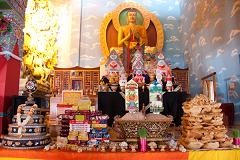 |
|
|
|
|
Holi |
|
Holi or Fagu Purnima is one of the most colorful and playful festivals of Nepal. The Holi festival is celebrated in the month of February. The chit pole are decorated with colorful flags and erected on the first day of Fagu at Kathmandu's Durbar Square. On this day, a formal announcement is made to all the people to hide their good clothes or you would be splashed with coloured powder and water balloons. On the last day, the youths cover their body with red vermillion powder and roam the streets. |
|
|
|
|
Ghode Jatra |
|
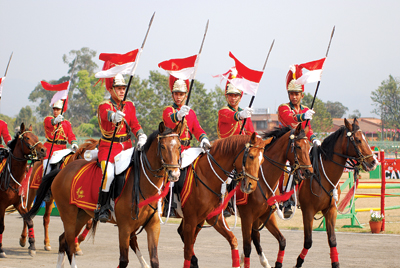 |
On the Ghode Jatra, the horses of the Nepalese army perform the graceful events before the public. According to the legends, this "horse festival" was celebrated after the people Kathmandu people buried a demon under the soil of Tundikhel
showground. They say that he may rise again and cause worry to the world if he is not trampled on by horses each year. So in the spring season, in the month of April, this victory over evil is celebrated in the valley by organizing palanquin processions and grand display of showjumping, motorcycling feats, and gymnastics. The King and Queen, the Living Goddess Kumari, and thousands of people from all over the country take part in the
festival. |
|
|
|
|
New Year's Day |
|
The Bikram Era is the official calendar of Nepal. This solar calendar was started by king Bikramditya and starts from the first day of the first month of Baisakh. The new year 2057 of the Bikram Era corresponds to 2000-2001 of the Christan Era. The New Year's Day is an official holiday. The first day of the month of Biasakh is observed as the Nepali New Year and falls in the second week of April. It is also known as Navavarsha in Nepal. On this day, the devotees visit the Pashupati temple to take a dip in the holy Bagmati river and visit other religious spots. The people People go for picnics, have get-togethers and celebrate the day by socializing in various ways. It is a day to seek blessings from family priest and one's elders as well. |
|
|
|
|
Buddha
Jayanti |
|
The Buddha Jayanti is observed as the birth of Lord Buddha on the full moon day in the month of May. The Lord Buddha was born in Nepal, and he preached Buddhism, which is the second most popular religion in Nepal. On this day, the people celebrate the Lord's birth, enlightenment, and salvation throughout the valley with celebrations. Before the coming of the festival, the Swayambhunath and Boudhnath Stupas are prepared for the festival several days in advance. The people clean the monasteries, polish the statues and monks prepare for the dance. On the Buddha Jayanti, people reach the stupas
before dawn, go around them and give offerings to the various
Buddha images. |
|
|
|
|
Gunla |
|
The Gunla festival is celebrated by the Buddhists of the Kathmandu valley in the month of August. This festival is celebrated to welcome the monsoon season. The celebrations of this festival was started about twenty-five centuries ago by the Buddha. It is a time for prayer, fasting, meditation and religious music. The devotees climb past jungles, stone animals, great statues of the Buddha, and begging monkeys to Swayambhu's hilltop where daily prayers begin before dawn. Important Buddhist statues, oil lamps, prayer flags and scroll paintings are displayed in the monasteries, and the teachings of Lord Buddha are remembered as the rains nurture the crop of rice, Nepal's most important crop. |
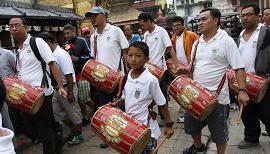
|
|
|
|
|
Krishnashtami |
|
The festival of Krishnashtami is celebrated in the month of August. This day is celebrated as the birthday of Lord Krishna, one of the incarnations of Lord Vishnu. On this day, an impressive ceremony takes place at the Krishna Temple in Patan and Changu Narayan
temple |
|
|
|
|
Janai Purnima
(Raksha Bandhan) |
|
The Janai Purnima or Raksha Bandhan is celebrated in the month of August. On this day the high-caste Hindus chant the powerful Gayatri mantra and change their Sacred Thread (janai). The people ties a red or yellow protection cord around the wrists of other Hindus and Buddhists. The pilgrims make a journey to the mountains north of Kathmandu. Here they please the Lord Shiva by bathing in the sacred lake of Gosaikund. Those unable lo make the trek celebrate at Shiva's Kumbheswar Mahadev temple. Here, a pool with an image of Shiva at its center is filled with water which is believed to have come from
Gosaikund. |
|
|
|
|
Gai Jatra |
|
The gai or cow is holy to Hindus. She represents Laxmi, the goddess of wealth, and guides the departed souls to the gates of the another world. The Gai Jatra or Cow festival is celebrated in the month of August. Satire, jokes, fancy costumes, and colorful processions are the part of the festival as the people recall how an eighteenth century king rallied his people to cheer his queen upon the death of their son. Those who have experienced the death of close ones during the past year share their sorrow and comfort so that the gai can safely transport the departed souls on their afterlife journey. The young men wear the women's saris, children dressed up as cows, and whimsical characters of all sorts fill the streets. The special issues of local magazines shower its fun on everyone and everything. |
|
|
|
|
Teej |
|
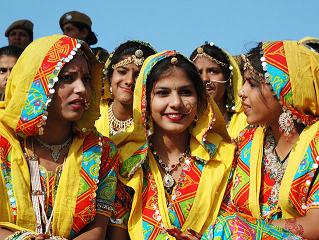 |
The festival of Teej is celebrated in the month of August. On this day, the women dressed up in thier fine red wedding saris visit the Pashupatinath temple of Shiva. The women celebrate the festival by fasting, folk songs, and dances and recall the goddess Parvati's devotion to her husband Shiva. The married women visit their fathers homes and all daughters and sisters receive gifts from their male kin, and an elaborate feast is prepared for them. It is a loud and cheerful celebration until late night, when strict fasting discontinues. On this day women observe a fast and pray to Lord Shiva for the long, healthy and prosperous life of their husbands and their families. The unmarried women also observe this festival with the hope that they will get to marry good husbands. The blessings of Shiva and Parbati ensure that family life will be joyous for all. |
|
|
|
|
Indra Jatra |
|
The festival of Indra Jatra is named after the Lord Indra, King of Heaven. This festival is celebrated by both the Buddhists and Hindus in the month of September in Nepal. On this day, the people worship the Lord Indra, to be grateful to him, who has blessed the valley. This festival is celebrated for eight days in the Durbar Square in Kathmandu with singing, mask dancing and rejoicing. On the first day, the Indra's dhwaj or flag is erected. It is said that many centuries ago, Indra's mother needed specially scented flowers but could not find them in heaven's gardens. Indra discovered parijat flowers in the Kathmandu Valley and tried to steal them for his mother. He was caught and imprisoned by the people of the valley. When Indra's mother came searching for him the people were punished for what they had done. As a result, they released Indra and dedicated one of the most colorful festivals of Nepal to him to appease his anger. On this
day, the masks and statues representing Vishnu, Bhairab,
and Shiva |
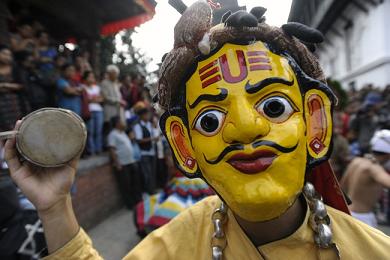 |
|
are shown to the public, and the Goddess Kumari witnesses the special occasion from her chariot. The chariot of the Living Goddess Kumari is taken through the main streets of Kathmandu. On the first day, the King of Nepal also pays homage to Goddess Kumari. The people gather at the streets of Kathmandu valley to enjoy the
festival. |
|
|
|
|
|
Dasain |
|
Dasain is the longest and most favourite festival of Nepal. This festival is celebrated in the month of October in Nepal. On this day, everyone stays at the home with their families, offices are closed. The skies are filled with kites and the marketplaces are filled with farmers bringing their buffaloes, goats and chicken to sell. These animals are then sacrificed on the night of Kal Ratri to please the goddess Durga. On the day of Dashami, everyone puts on new clothes and goes to honour their family elders, where they receive large red tikas of vermilion paste on their foreheads. In the following days of Dasain, families and friends unite, take part in the feasts, impart the blessings and exchange the gifts. |
|
|
|
|
Tihar |
|
Tihar also known as the Festival of Lights is celebrated in the month of November. This festival is a time of candlelight, tinsel decorations and festive colored sweets. This festival is celebrated for five days and on different days, there are offerings and small celebrations for crows, dogs, cows and oxen. On the night of Lakshmi Puja, garlands are hung and lamps are lighted to invite Lakshmi, the goddess of wealth into the home. Maha Puja, the New Year's Day according to the Nepal Era is celebrated as the day of the self, when people give themselves blessings to remain healthy and happy for the rest of the year. On Bhai Tika, the last day, the sisters make offerings to their brothers and the rituals include breaking of walnut, putting on garlands of makhamali flowers and encircling brothers in rings of mustard oil to protect them from Yama, lord of the Netherworld. |
|
|
|
|
|
|

